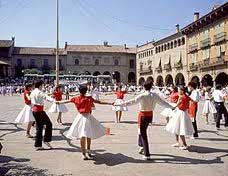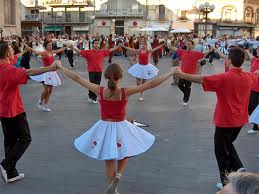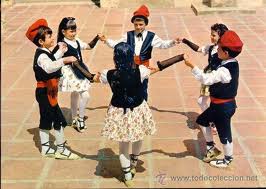Sardana
The Sardana is a traditional Spanish dance which is danced in a circle while holding hands, and is native to the Spanish region of Catalonia. It originated in the historical region of Empordá, in the North-east of the Catalan region, but became popular across Catalonia during the 20th Century.
Sardana

While the date of the origins of this Spanish dance is unclear, as some people believe that the Sardana was already very popular as early as the 16th Century, what is clear is that it was popular in Empordá in the latter part of the 19th Century. The 19th Century saw the Sardana exploding in popularity, carrying it across the Catalan region. The Sardana became so famous that it came to stand for Catalan identity and nationalism after the 'Renaixença' (Renaissance) in Catalonia at the beginning of the 19th Century.
Like many other Spanish folk dances, the Sardana was choreographed, although this happened to the Sardana much later than other dances, in the late 19th Century. The resulting choreographed product contained slight differences to the original version of the Sardana from Empordá.
After the Spanish Civil War, and the arrival of the dictatorship of General Francisco Franco, the Sardana, along with many other regional traditions, was banned for being a symbol of the Catalan identity and nationalism. In 2010 however, the Catalan government declared that the Sardana was worthy enough to be added to their list of Catalan festivities and made it a dance of national interest.

The music that accompanies the Sardana is played by a 'cobla', the name of the Sardana band. This band consists of ten wind instruments, a double bass and a small drum called a 'tamborí'. Five of the wind instruments are woodwind instruments which include a small flute-like insruments called a 'flabiol', and two of both the 'tenora' and 'tible' which belong to the same musical family as the oboe. The other five wind instruments are brass instruments which include two fiscorns which are a type of saxhorn, two trumpets, and a trombone. Today there are over a hundred 'coblas' in Catalonia.
The music itself tends to be focused around a 6/8 rhythm, which Pep Ventura's band is credited for stabilizing, yet it can also be performed in 2/4. It consists in two sections or 'tirades' which are repeated in a pattern to produce the full length song for the dance. The two sections are called 'curts' (short steps) and 'llargs' (long steps).
A Sardana normally begins with an 'introit' which is an introduction played by the 'flabiol'. Then the 'tamborí' is tapped once to let the dancers know that it is time to start the dance. Normally, the dancers then perform the 'curts' which are short steps with the arms down. The 'llargs' then follow which are long steps with arms at shoulder height. These sections are then repeated in a pattern before the 'contrapunt' which is sort of an intermission section, again played by the 'flabiol'. Another set of 'llargs' are performed before the final part of the dance. The dance ends with the 'cop final' (final beat) where all the Sardana dancers, also called 'sardanistes', stop with one unified movement.

The Sardana is not a particular fast Spanish dance, compared to some of the other dances in Spain, and is therefore easy for newcomers to learn. It also means you do not have to be overly physically fit or a professional dancer to take part either!
Being a circle dance, the Sardana is very variable, especially in terms of the number of dancers. Often when a Sardana begins to be performed in a street or at a party, people come along and join in, hence the circle gets bigger and bigger. Normally, people in the circle alternate in gender, i.e. man, woman, man, woman.
Professional dancing troupes of Sardanas also exist and are called 'colles'. These organized groups tend to have their own costumes or outfits which are specific to their 'colla'. For example, the 'Colla Estol-Espígol', a group from Agramunt, to the West of Barcelona, wear white clothes with green saches, belts, gloves, trousers and shoes.
